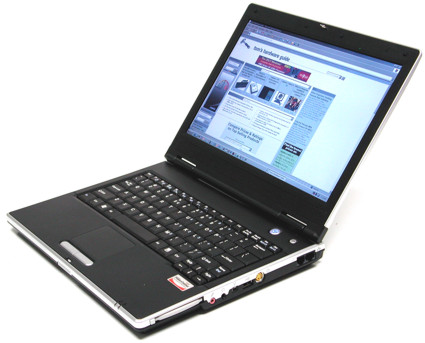Building Your Dream Notebook
Step 1. Choosing The "Right" Barebook/Notebook
Before you begin ordering the barebook and all associated components, you need to be clear what the main purpose of the machine is going to be and what your own habits of use are like.
For example, if you are a hard-core gamer, battery life or mobility will be less important - or not important at all. What will count mainly for you is 3-D performance, 3-D performance and - did I mention this already - 3-D performance. This target group wants to play today's games with the maximum possible quality settings on their notebooks as well. In that case, the choice will be a device with a large screen, if possible a swappable graphics subsystem and maximum expandability. Gamers will usually tolerate desktop CPUs and the associated noise level: after all, the graphics processor and CPU need to be cooled, and powerful and usually loud fans are required to do that.
The average user who has low to medium gaming ambitions and uses the device primarily for standard business applications, will be well served with a 15" device and dedicated graphics chip. Anyone who also frequently uses the notebook as a DVD video player should think about using a bare-bones with a 15.4" display and wide-screen resolution. However, it should be noted that as the diagonal measurement increases, the weight increases and battery life decreases in the same proportion. In other words, a larger screen means less mobility; in today's notebooks, the display consumes about 30% of a notebook's power, making it one of the components that represent the greatest power drain. Also, notebooks with a PCI Express graphics chip have a battery life that is up to 30 minutes shorter than systems with an AGP graphics chip. Anyone who decides in favor of a system with a power-saving mobile CPU rather than a processor that heats up like a desktop hot plate will gain more than some 20 minutes battery life in normal operation - the noise level of a device equipped with a mobile processor of AMD Turion, mobile Athlon XP or Pentium M caliber will be significantly lower as well. That's always assuming that the engineers have properly tuned power management, cooling system and fan control with one another.
Those who only use office programs, read e-mails, surf the web and play MP 3 files as background music, can easily do without a dedicated graphics chip. The efficiency of current integrated graphics solutions in combination with popular CPUs is more than adequate for these tasks.
Nor is playback of DVD videos a problem for these machines with an integrated graphics chip. In addition, this user group should consider the following: the smaller the screen diagonal and the more energy-efficient the CPU, the higher the mobility. So anyone who mainly transports his or her machine from Desk A to Desk B in his car will be best off with a 15" or 15.4" device. On the other hand, anyone who wants mobility, i.e. the most portable device possible combined with longer battery life, cannot avoid relying on a smaller screen diagonal such as a 13.3" or 12.1" one. However, it is important to remember that smaller notebooks usually have smaller battery capacity as well. The notion that a 12.1" device is lighter and runs longer than a notebook with a display that measures only 13.3 or 14 inches is therefore not necessarily correct. Because often, you "pay" for the smaller form factor and lower weight with less battery life due to the smaller battery capacity. A high-capacity battery or second battery can help, but then this increases the weight again.
As just outlined, therefore, you should think hard about the following before choosing a particular notebook or barebook:
- what applications you primarily use;
- how important mobility is.
The guide above does not claim to be complete, but definitely offers several good points to consider.
Get Tom's Hardware's best news and in-depth reviews, straight to your inbox.
For this project we chose a machine:
- that handles typical business applications without problems;
- won't take up too much of your carry-on capacity;
- that is supposed to offer acceptable battery life.
We thus chose a barebook from Uniwill, the 223II00.
The 233II00 from Uniwill
This 12.1" model is based on Intel's 855GME chipset, which has an integrated graphics core. In combination with a Pentium M CPU and a WLAN module from Intel, this barebook can be made into a "real" Centrino device. This brings us already to the next question, that of choosing the right components.
Current page: Step 1. Choosing The "Right" Barebook/Notebook
Prev Page What Is A DIY Notebook? Next Page Step 2. Component Selection